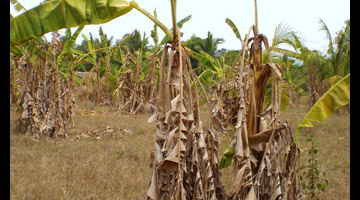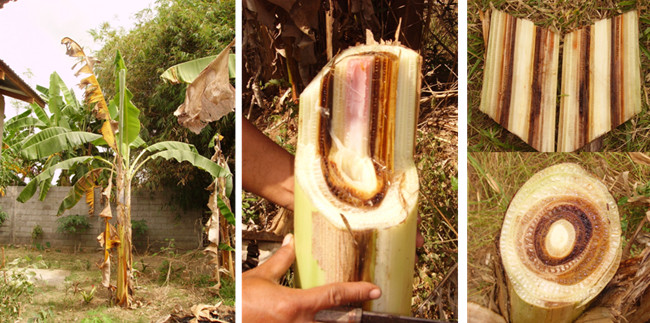 The Philippine Council for Agriculture, Aquatic and Natural Resources Research and Development (PCAARRD) is currently addressing the major problem of banana growers in Mindanao --- the Panama disease or Fusarium wilt.
The Philippine Council for Agriculture, Aquatic and Natural Resources Research and Development (PCAARRD) is currently addressing the major problem of banana growers in Mindanao --- the Panama disease or Fusarium wilt.
Together with partners from the industry and other government agencies, and Bioversity International, short- and long-term strategies were laid out to curb the much dreaded disease.
Foremost among the immediate steps recommended by the group is to prevent the further spread of the disease through a two-pronged approach: early detection of disease and a monitoring and eradication program.
In the former, farmers will be trained to recognize disease symptoms early so that the diseased plants can be immediately eradicated. In the latter, infected plants will be destroyed to prevent spread of the disease. The group also recommends that the protocol for management of the disease be shared as widely as possible.
For the long term, the two important initiatives are the conduct of on-site trials of resistant variety GCTCV-119, and the establishment of a Banana Research Center. GCTCV-119 is a Cavendish variety with resistance to Fusarium oxysporum f. sp. cubense, the fungus that causes the Panama disease.
The location trials of the variety will determine how the GCTCV-119 will fare in soil that is already infested by the fungus. Also, partners will be piloting fertilization methods to include the use of organic fertilizer. Toward this initiative, Bioversity International, through Lapanday Foods Corporation in Davao City, will produce 1,000 planting materials through tissue culture to be distributed to members of the Philippine Banana Growers and Exporters Association.
The mother plants for the tissue culture will come from the National Germplasm Collection housed at the Bureau of Plant Industry–Davao National Crops Research and Development Center. Bioversity International and PCAARRD will develop the protocol for crop management. Further, the Council will lead the monitoring and evaluation of the project. Incidentally, a proposal on this is in the offing.
R&D for disease management
 In 2005, PCAARRD funded surveys of banana-growing areas for Fusarium infection as part of the S&T Anchor Program (STAP) for Banana. In Luzon and Visayas, the provinces surveyed include Camarines Sur, Quezon, Laguna, Oriental Mindoro, Isabela, Quirino, Nueva Nizcaya, and Negros Oriental. In Mindanao, the survey covered Compostela Valley, Davao del Sur, Davao del Norte, Davao Oriental and Davao City.
In 2005, PCAARRD funded surveys of banana-growing areas for Fusarium infection as part of the S&T Anchor Program (STAP) for Banana. In Luzon and Visayas, the provinces surveyed include Camarines Sur, Quezon, Laguna, Oriental Mindoro, Isabela, Quirino, Nueva Nizcaya, and Negros Oriental. In Mindanao, the survey covered Compostela Valley, Davao del Sur, Davao del Norte, Davao Oriental and Davao City.
Maps of the disease incidence were developed for the Luzon and Visayas areas in collaboration with the National Mapping and Resource Information Authority. Surveys here showed that the Latundan variety was most infected. On the other hand in Davao, there was no reported incidence in Davao del Sur and only a low level was reported in Davao del Norte and Davao Oriental. Here, infection was most severe on VCG1213/16, a Cavendish variety.
Research on banana showed that the use of endophytic fungi (EF) can be a key component in the integrated management of the disease. EF are found in the roots of healthy banana plants and can reduce the growth of Fusarium oxysporum f.sp. cubense (Foc) in vitro. In infested soil, EF can prevent the stunting of plants. Researchers found three isolates of Aspergillus (designated as Aspergillus sp. EF 1, 25, and 26) that can be used for this treatment.
In Davao where a high incidence of the Fusarium wilt race 4 was noted, researchers proved that the application of commercial microbial fertilizer at the nursery promotes plant vigor and could decrease the disease incidence in the field. Likewise, the fungus Trichoderma harzianum and commercial microbial fertilizer are potential control agents of the Foc. However, these practices could not beat the use of resistant varieties.
The evaluation of new varieties from Taiwan, including Cavendish varieties GCTCV-119 and GCTCV-218, was initiated under the STAP on Banana. With the support of Bioversity International through the National Repository, Multiplication and Dissemination Centers, these varieties were evaluated in commercial plantations in Davao.
Compared to the commercial varieties Grand Naine and Williams, the GCTCV-119 and 218 were highly resistant to race 4 of Foc and have comparable yield and fruit quality.
Building on the gains of focused R&D and on public-private partnership, the path for the management of Panama disease is clear. The government, through PCAARRD, Bioversity International, and partners in the public and private sectors, are taking action.
